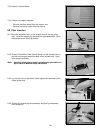17
11.03 Stripper Blades - Replacement
a. If the stripper performance is unsatisfactory after a thorough cleaning, the blades need to be replaced.
Remove the blades per 11.02 b.
b. Place the new blades into the pivot housing per 11.02 d and e.
Hint 2: Stripping in Hot Temperatures:
At high temperatures, the heating time will be less. At a temperature of 100〉 F (40〉 C), the heating time
should be approximately 6 to 8 seconds. For other temperatures, adjust the time accordingly.
Hint 3: Stripping Ribbonized Fibers:
Sometimes stripping ribbonized fiber can be difficult. This is due to the fiber, not the ribbonizing process.
The coating material of some loose tube fibers reacts to heat and bonds to the glass. If this is the case, the
stripped fibers will have heavy residue that cannot be easily wiped off. This type of fiber must be stripped
with less heat. Therefore, heat it only a short time and then pull hard on the ribbon, to move it through the
tool quickly. See Hint 5.
Hint 4: Broken Fibers:
When stripping the ribbon, sometimes broken fibers occur. Fibers broken at the very beginning of the strip
are usually caused by poorly made ribbon or using the wrong size tube guide. Always close the handles
slowly, as this allows the fibers to align with the blades.
Fibers that are broken somewhere along the length of fibers are caused by stripping technique or poor
ribbon. Try heating the ribbon longer, pulling more slowly, and being careful to pull the ribbon straight out of
the tool.
Hint 5: Fiber Residue:
After cleaning the fibers, some residue may remain. Often the residue is found on the region of glass that is
removed in the cleaving process, so is not a problem (if it doesn't affect the cleave). Sometimes, residue
can be seen on the portion of glass that is to be inserted into the splice. A light amount of residue found
along the sides of the fibers or away from the cleaved ends will not affect the splice. But if residue is found
on the top or bottom of the glass and near the cleaved ends, the fibers should be re-stripped, cleaned, and
cleaved.
Hint 6: Disposing of Cleaved Fiber Stubs:
With some cleaver models, the fiber stubs can be grasped before opening the clamping lid, as shown in
6.10. This is the easiest way to dispose of cleaved stubs. With other models the clamping lid must be
opened first. In this case, using adhesive-backed tape is a convenient way to collect the fiber ends.
Hint 7: Viewing the Cleaved Ends:
The key to good inspection is good lighting. Allow light to enter from the side of the cleaver that the holder
is on. This is the top and left for the Fujikura cleaver, and the top and right for the Sumitomo cleaver. In
dark areas, use the penlight provided in the kit for additional lighting.
Hint 8: Laying the Fibers into the V-Grooves:
Sometimes the fibers are difficult to lay into the V-grooves, because they have shifted to one side or the
other. To solve the problem, lift the holder up and grasp the coated ribbon between the holder and the bare
fiber. Now shift the ribbon in the appropriate direction. The fibers should now lay into the V-grooves.
12.0 Helpful Hints
Hint 1: Stripping in Cold Temperatures:
When stripping in cold temperatures, the heating time for the stripper will be longer. For an ambient
temperature around 32〉 F (0〉 C), most ribbons should be heated approximately 12 to 15 seconds before
pulling the ribbon through. The handles can also be held closed for a longer time without damaging the
heater unit.


















